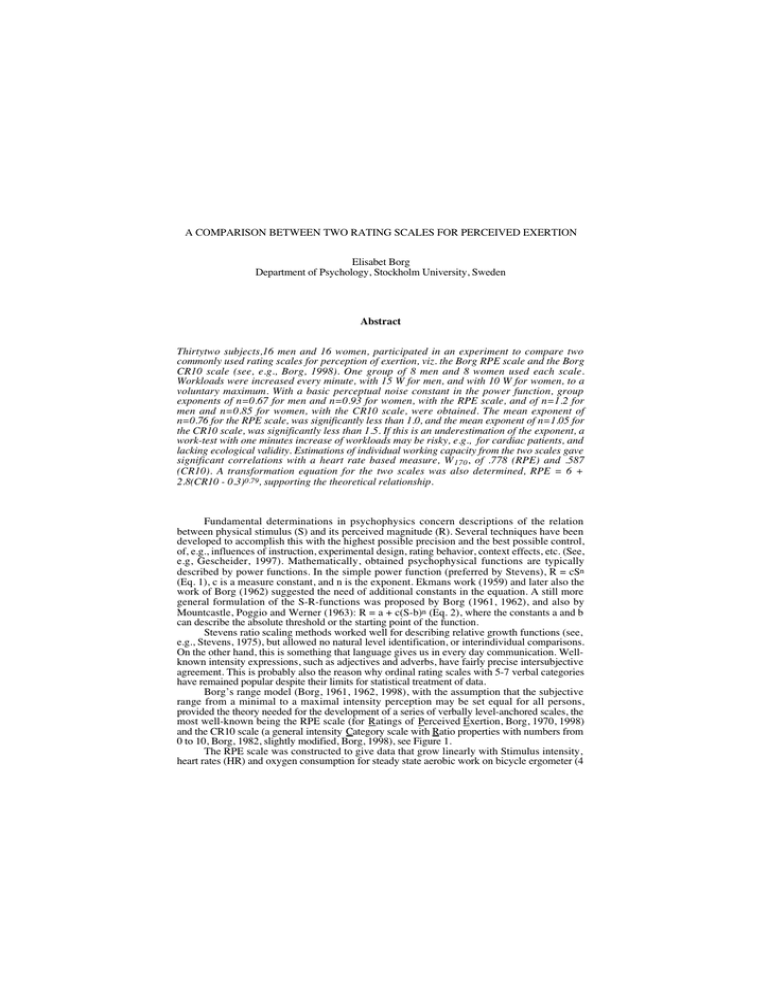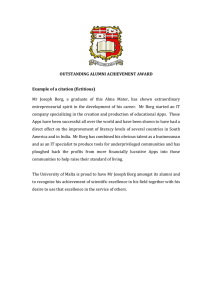A Comparison between two Rating Scales for Perceived Exertion
advertisement

A COMPARISON BETWEEN TWO RATING SCALES FOR PERCEIVED EXERTION
Elisabet Borg
Department of Psychology, Stockholm University, Sweden
Abstract
Thirtytwo subjects,16 men and 16 women, participated in an experiment to compare two
commonly used rating scales for perception of exertion, viz. the Borg RPE scale and the Borg
CR10 scale (see, e.g., Borg, 1998). One group of 8 men and 8 women used each scale.
Workloads were increased every minute, with 15 W for men, and with 10 W for women, to a
voluntary maximum. With a basic perceptual noise constant in the power function, group
exponents of n=0.67 for men and n=0.93 for women, with the RPE scale, and of n=1.2 for
men and n=0.85 for women, with the CR10 scale, were obtained. The mean exponent of
n=0.76 for the RPE scale, was significantly less than 1.0, and the mean exponent of n=1.05 for
the CR10 scale, was significantly less than 1.5. If this is an underestimation of the exponent, a
work-test with one minutes increase of workloads may be risky, e.g., for cardiac patients, and
lacking ecological validity. Estimations of individual working capacity from the two scales gave
significant correlations with a heart rate based measure, W 170 , of .778 (RPE) and .587
(CR10). A transformation equation for the two scales was also determined, RPE = 6 +
2.8(CR10 - 0.3)0.79, supporting the theoretical relationship.
Fundamental determinations in psychophysics concern descriptions of the relation
between physical stimulus (S) and its perceived magnitude (R). Several techniques have been
developed to accomplish this with the highest possible precision and the best possible control,
of, e.g., influences of instruction, experimental design, rating behavior, context effects, etc. (See,
e.g, Gescheider, 1997). Mathematically, obtained psychophysical functions are typically
described by power functions. In the simple power function (preferred by Stevens), R = cSn
(Eq. 1), c is a measure constant, and n is the exponent. Ekmans work (1959) and later also the
work of Borg (1962) suggested the need of additional constants in the equation. A still more
general formulation of the S-R-functions was proposed by Borg (1961, 1962), and also by
Mountcastle, Poggio and Werner (1963): R = a + c(S-b)n (Eq. 2), where the constants a and b
can describe the absolute threshold or the starting point of the function.
Stevens ratio scaling methods worked well for describing relative growth functions (see,
e.g., Stevens, 1975), but allowed no natural level identification, or interindividual comparisons.
On the other hand, this is something that language gives us in every day communication. Wellknown intensity expressions, such as adjectives and adverbs, have fairly precise intersubjective
agreement. This is probably also the reason why ordinal rating scales with 5-7 verbal categories
have remained popular despite their limits for statistical treatment of data.
Borg’s range model (Borg, 1961, 1962, 1998), with the assumption that the subjective
range from a minimal to a maximal intensity perception may be set equal for all persons,
provided the theory needed for the development of a series of verbally level-anchored scales, the
most well-known being the RPE scale (for Ratings of Perceived Exertion, Borg, 1970, 1998)
and the CR10 scale (a general intensity Category scale with Ratio properties with numbers from
0 to 10, Borg, 1982, slightly modified, Borg, 1998), see Figure 1.
The RPE scale was constructed to give data that grow linearly with Stimulus intensity,
heart rates (HR) and oxygen consumption for steady state aerobic work on bicycle ergometer (4
to 6 minutes). Because of its construction it can be said to give interval data (with regard to
aerobic demands). To underscore this, the scale starts with the number 6 (and not zero), and the
number range from 6 to 20 roughly corresponds to a HR range from 60 to 200 beats x
minute–1 in healthy people, about 30 - 40 years old. The linear growth function of RPE data has
been confirmed in several studies (see, e.g., Borg, 1998, Noble and Robertsson, 1996)
On the CR10 scale the verbal anchors and numbers are placed congruently to render ratio
data that mimic what is obtained by magnitude estimation. (For a thorough description of the
scales, see Borg, 1998; Borg and Borg, 2001 (in press)).
a)
6
7
No exertion at all
0,5
Very light
1
2
Light
Very weak
Light
Weak
2,5
3
Somewhat hard
Moderate
4
5
Strong
Heavy
6
Hard
(heavy)
7
Very strong
8
16
17
"No I"
Just noticeable
1,5
14
15
Extremely weak
0,7
12
13
Nothing at all
0,3
10
11
0
Extremely light
8
9
b)
Very hard
18
9
10
Extremely strong "Strongest I"
11
19
Extremely hard
20
Maximal exertion
•
Absolute maximum
Highest possible
© Gunnar Borg, 1982, 1998
© Gunnar Borg, 1970, 1985, 1998
Figure 1. a) the Borg RPE scale and b) the Borg CR10 scale.
The psychophysical growth function for perceived exertion has been determined by Borg
(1961, 1962), and the exponent found to be about 1.5 (usually between 1.5 and 1.7). This has
also been confirmed in several later studies (see, e.g., Borg, 1998). Most studies on perceived
exertion with the RPE scale have employed steady-state work on bicycle ergometer, with a stepwise increase of exercise levels every 4th to 6th minute (Borg, 1970, 1998). In Sweden it has,
however, recently become popular in clinical situations to increase the work load every minute.
This is done to avoid the relatively large increase in work loads necessary with steady-state
work, and to avoid extrapolations (for patients who interrupt the work on a certain work load
before time) (See, e.g., Nordenfelt, 1992). With the CR10 scale and other ratio scaling methods,
short-time work (perceived “pedal resistance” at 30 - 60 s of work on randomized S-levels with
rest between each level) has sometimes also been used (see, e.g, Borg, 1962, 1982, 1998).
The aim of this article is a comparison between the two now very commonly used rating
scales for perception of exertion, viz. the Borg RPE scale and the Borg CR10 scale on a worktest with step-wise increase of exercise levels every minute. Of interest is the psychophysical
functions obtained, the possibility of using obtained data for estimations of individual working
capacity, and how well the two scales function for interindividual comparisons. A transformation
equation between the two scales will also be computed.
Method
Thirtytwo subjects,16 men and 16 women, participated in an experiment on the perception
of exertion during a work-test to a voluntary maximum on bicycle ergometer. The subjects were
divided into four groups of 8 men and 8 women in each group depending upon which
psychophysical method they were to use (se below). Individual data for the four groups of
subjects are presented in Table 1. A commonly used measurement of individual working
capacity, the power level at a heart rate of 170 beats x minutes–1 (W 170), is also included (this
measurement is obtained from individual HR - S functions, cp. Wahlund, 1948).
The psychophysical methods used were the Borg RPE scale and the Borg CR10 scale
presented in Figure 1 (see also Table 1). An instruction was read to the subjects at the beginning
of the experiment and the scales were visible to the subjects throughout the whole work-test.
Subjects worked at an electrically braked bicycle ergometer (Rodby) and were instructed to keep
a pedaling rate of 60 rpm. For the male subjects workloads were increased with 15 W every
minute, for the female subjects workloads were increased with 10 W every minute. Subjects
were instructed to continue pedaling as long as they possibly could. During the last 10 seconds
of each workload they were asked to give a rating of their perceived overall exertion. Heart rates
were measured continuously by electrocardiometry.
Table 1.
Mean values (M) and standard deviations (sd) for age, height, weight and estimated
working capacity (W170) for the four groups of subjects.
Group
n
Men, RPE
Men, CR10
Women, RPE
Women, CR10
8
8
8
8
Age (years)
M
sd
30.4
30.6
29.4
30.8
3.8
3.2
5.8
6.2
Height (cm)
M
sd
178.6
180.4
167.8
169.1
8.4
6.4
9.6
9.5
Weight (kg)
M
sd
80.7
81.6
70.5
64.0
13.4
6.3
12.4
7.8
W 170 (W)
M
sd
268.6
249.1
179.9
162.2
32.6
17.4
42.8
34.3
Results
Psychophysical group-functions were calculated by the method of least squares for men
and women separately. For men 12 S-levels (20 - 240 W) were used and for women 11 S-levels
(15 - 165 W) were used (with one extrapolated value). Since the RPE scale can be regarded as
rendering interval data (but not ratio) arithmetic means were used in the calculations, but for the
CR10 scale geometric means were used. The results are shown in Figure 2. For the RPE scale,
an a-value of a = 6 gave the best fit correlation for men as well as for women, and an exponent
of n = 0.67 was obtained for men, and of n = 0.93 for women. For the CR10 scale, an a-value of
a = 0.3 was obtained, giving an exponent of n = 1.2 for men, and n = 0.85 for women.
Individual psychophysical functions were also calculated. For the RPE scale an a-value
was needed for 15 subjects (0 ≤ a ≤ 7.5, mean = 4.9, s = 1.9), giving a mean exponent of n =
0.76 (s = 0.43). A one-sample t-test revealed that this was significantly lower than the postulated
exponent of 1.0, t 15 = -2.17 (p < 0.05). For the eight men the mean exponent was n = 0.58 (s =
0.31) which was significantly less than 1.0, t 7 = -3.8 (p < 0.01), and for the eight women the
mean exponent was n = 0.94 (s = 0.49), which was not significantly less than 1.0. (t7 = -0.33).
If the a-value was forced to a = 6 for all individuals the mean exponent obtained for the 16
subjects was n = 0.87 (s = 0.35) which was not significantly different from n = 1.0, t15 = -1.53
(p = 0.15).
For CR10 data, the mean exponent when no extra constants were used was n = 0.92 (s =
0.31). With individual a-values of 0 ≤ a ≤ 1.0 in the psychophysical functions the mean
exponent was n = 1.05 (s = 0.24). A one-sample t-test revealed that this was significantly lower,
t15 = -7.4 (p < 0.0001), than what has been previously obtained with steady state work of 3 to 6
minutes on each work load (n ≥ 1.5). The mean exponent for the eight men was n = 1.2 (s =
0.23) which was significantly less than 1.5, t 7 = -4.1 (p < 0.01), and for the eight women it was
n = 0.94 (s = 0.21), also significantly less than 1.5, t7 = -7.7 (p < 0.001).
Ratings (RPE/CR10)
20
15
10
5
0
0
100
200
300
Stimulus (Watt)
Men RPE (n=8)
RPE = 6 + 0.290 • S0.67
rxy = .998
Women RPE (n=8)
RPE = 6 + 0.108 • S0.93
rxy = .993
Men CR10 (n=8)
CR10 = 0.3 + 0.00928 • S1.2
rxy = .997
Women CR10 (n=8)
CR10 = 0.3 + 0.0856 • S0.85
rxy = .997
Figure 2. Psychophysical group functions for men and women for the two rating scales.
Group heart rate functions where calculated by linear regressions of arithmetic means.
The relationships obtained where with the RPE scale: HR = 0.35 x S + 75.8 (rxy = .996), for
men, and HR = 0.51 x S + 80.3 (rxy = .995), for women; with the CR10 scale: HR = 0.50 x S
+ 71.9 (rxy = .997), for men, and HR = 0.54 x S + 76.6 (rxy = .998) for women.
Measurements of individual working capacity were calculated from the RPE ratings (an
estimation of the power level at RPE = 17, W17) and from the CR10 ratings (an estimation of
the power level at CR10 = 7, W 7), by using the individual psychophysical functions. With the
RPE scale the mean value for men was W17 = 234.6 (s = 49.7) watts and for women W17 =
151.9 (s = 35.3) watts. With the CR10 scale the mean value for men was W7 = 247.4 (s = 92.3)
watts and for women W7 = 172.6 (s = 72.6) watts.
Individual working capacity estimated from the ratings (W 17 and W7) were correlated
with W170 (estimated from individual heart rates). The results are shown in Table 2. Significant
correlations of .778 and .587 were obtained for the total groups of N=16. No significant
correlations were found for the male group, but for the female group significant correlations of
.850 and .735 were obtained.
The relationship between the two scales, if RPE-values are plotted against CR10-values,
can, because of how the two scales are constructed, be expected to grow according to a slightly
negatively accelerating function. If the numerical values of the verbal anchors are used as data a
theoretical relationship (with a theoretical a-value of 6 for the RPE scale and a b-value of 0.3 for
CR10 giving the highest best fit correlation) will be obtained of: RPE = 6 + 3.7 x (CR10 0.3) 0.57 (r xy = .999). Obtained RPE ratings were plotted against CR10 ratings (for the
collapsed groups of 8 men and 8 women using each scale). The resulting relationship could be
described with the negatively accelerating power function (with the same a- and b-values as
above): RPE = 6 + 2.8 x (CR10 - 0.3) 0.79, with a best fit correlation of r xy = .991 for the total
group. For men the relationship found was: RPE = 6 + 4.0 x (CR10 - 0.3)0.56, r xy = .991, and
for women it was: RPE = 6 + 1.6 x (CR10 - 0.3)1.1, rxy = .989.
Table 2.
Correlations between W170 ,W17 and W7.
Total (N=16)
W 170 ,W17
W 170 ,W7
***
p ≤ 0.001
Men (N=8)
.778 ***
.587 *
**
p ≤ 0.01
.226
.175
*
Women (N=8)
.850 ***
.735 *
p ≤ 0.05
Discussion
Data obtained from both scales could be well described with power functions with an
additional basic noise constant on the response side, an a-value in Eq. 2. For the RPE scale an avalue of a = 6 was obtained, in agreement with the scale construction (se, e.g., Borg, 1998). For
the CR10 scale the a-value obtained was a = 0.3, which is in agreement with previous results of
an a-value of about 3-4% of a maximal response (also with traditional ratio scaling techniques),
as well as with evidence of physiological activities (”noise”) existing already at rest for
perceived exertion (Borg, 1962, 1998). The exponents obtained with both scales proved to be
significantly lower than what has been obtained previously (except for women with the RPE
scale). An explanation for this may lay in the test procedure, as a work-test with a step-wise
increase of only one minute at each level was used. The results of a lower exponent for shorter
duration may also be in harmony with what was found by Borg and Dahlström (1960). They let
subjects produce half-values of preset exercise levels and found that for very short durations (5
s) the resulting S-levels produced where close to half of the standards, whereas for durations of
30 - 100 s the produced S-levels where more than half of the standards (and more in agreement
with an exponent of 1.6). They concluded that “the perceived performance thus appears not
only to depend upon the physical force, but also on the amount of work carried out” (p. 25).
If the exponent is underestimated, the perception of exertion for any stimulus level will be
overestimated, and what is left from a safe level to “max” is underestimated. This may be of
danger, e.g., for cardiac patients, when they in ordinary daily life situations need to rely on their
perception not to overexert themselves. A patient who, e.g., is told to work at “R7”, judged to be
“safe” from the 1-minute test, might thus end up working at a “risky” level when leaving the
laboratory (see Figure 3). A work-test with such rapid increase as every minute, may be of a
more anaerobic than aerobic character. The exponent may thus be reflecting a qualitatively
different kind of experience, compared to what is obtained with steady state work or short-time
work with rest between work loads, and the 1-minute work-test may be lacking ecological
validity.
The differences in exponents between men and women, may depend upon differences in
individual rating behavior. Given the fairly small sample, further research is, however, needed to
study if this is a genuine difference between men and women.
The estimations of individual working capacity derived from the two scales, W17 and W7,
worked fairly well as compared to W170. This can be seen from the levels of W 17 and W7, as
well as by the correlations with W170 for the total groups of 16 individuals with each scale. The
correlations were a little bit higher for the RPE scale, probably depending partly upon its
construction to grow linearly with HRs and partly upon a restriction of range in working
capacity for the groups using the CR10 scale (see Table 1). For the two groups of men there
were no significant correlations. This might depend upon too homogenous groups, as can be
seen by the very much smaller standard deviations in W170 for the male groups.
A transformation equation could be determined that supported the theoretical relationship
between the two scales. As both scales work well for the perception of exertion, data obtained
with either scale can be freely transformed to the other one if comparisons are desired.
CR10
00000
11111
1
1111
100000
1
00000
111
1
1
00000
111
1
1
00000
111
100000
1
111
1
1
00000
111
1
1
00000
111
11111
00000
"risk"
"max"
{
7
d
ate
im
t
s
"
re
ue
de
"tr
un
"safe level"
S
Figure 3. A theoretical figure illustrating the danger of an underestimated exponent in the
psychophysical function of perceived exertion.
Acknowledgment
The research in this paper was supported by a grant from the Swedish National Center
for Research in Sports (2/00) to Berglund, Kaijser and Borg.
References
Borg, G. (1961). Interindividual scaling and perception of muscular force. Kungliga
fysiografiska sällskapets i Lund förhandlingar, 31, 117-125.
Borg, G. (1962). Physical performance and perceived exertion. (Studia Psychologica et
Paedagogica. Series altera, Investigationes XI.) Lund: Gleerup.
Borg, G. (1970). Perceived exertion as an indicator of somatic stress. Scandinavian Journal of
Rehabilitation Medicine, 2, 92-98.
Borg, G. (1982). A category scale with ratio properties for intermodal and interindividual
comparisons.In: H.-G. Geissler and P. Petzold (Eds.), Psychophysical Judgement and
the Process of Perception (pp. 25-34). Berlin: VEB Deutscher Verlag der
Wissenschaften.
Borg, G. (1998). Borg’s Perceived Exertion and Pain Scales. Champaign, IL: Human Kinetics.
Borg, G., and Borg, E. (2001). A new generation of scaling methods: Level-anchored ratio
scaling. Psychologica. In press.
Borg, G., and Dahlström, H. (1960). The perception of muscular force. Umeå vetenskapliga
biblioteks skriftserie, 5, 3-27.
Ekman, G. (1959). Weber's law and related functions. Journal of Psychology, 47, 343-352.
Gescheider, G. A. (1997). Psychophysics. The Fundamentals (3rd ed.). Mahwah, NJ: Lawrence
Erlbaum.
Mountcastle, V. B., Poggio, G. F., & Werner, G. (1963). The relation of thalamic cell response
to peripheral stimuli varied over an intensive continuum. Journal of Neurophysiology, 26,
807-834.
Noble, B. J. and Robertsson, R. J. (1996). Perceived Exertion. Champaign, IL: Human Kinetics.
Nordenfelt, I. (1992). Arbetsförmåga. In: O. Palm, S.-E. Svensson, and B. Wranne (Eds.), Det
kliniska arbetsprovet (pp. 69-72). Lund, Sweden: Studentlitteratur AB.
Stevens, S. S. (1975). Psychophysics: Introduction to its perceptual, neural, and social
prospects (G. Stevens, Ed.). New York: Wiley.
Wahlund, H. (1948). Determination of the physical working capacity, Acta Medica Scandinavia
(Suppl. 215).


